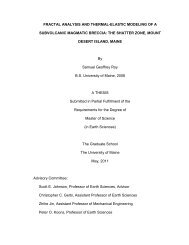Latis II Underwater Remotely Operated Vehicle Technical Report
Latis II Underwater Remotely Operated Vehicle Technical Report
Latis II Underwater Remotely Operated Vehicle Technical Report
Create successful ePaper yourself
Turn your PDF publications into a flip-book with our unique Google optimized e-Paper software.
CHALLENGES<br />
One of the most difficult challenges faced by<br />
the UMaine Team was preparing the ROV to<br />
operate in a submerged environment. Due to<br />
the extensive electronic systems both inside<br />
and outside the electronics enclosure, excellent<br />
waterproofing processes were essential. To<br />
address this challenge, initial testing was<br />
conducted on prototype, <strong>Latis</strong> I. The<br />
information gained from these tests influenced<br />
the final ROV design. For example, difficulties<br />
with small leaks through the waterproof<br />
connectors led to a final design with a<br />
permanent wire configuration and only<br />
installing a single removable part to access the<br />
sealed enclosure. Furthermore, sealing<br />
compounds such as potting epoxy were used<br />
more on <strong>Latis</strong> <strong>II</strong> because of the hardening<br />
capabilities not observed when using silicone or<br />
polyurethane.<br />
Another challenge faced by the team was<br />
dealing with conflicting opinions within the<br />
group regarding the steps to address a technical<br />
issue or the particular technical issue itself. It<br />
became obvious to the team that a process for<br />
resolving such conflicts would increase the<br />
productivity while avoiding interpersonal<br />
aggravations. To solve this problem it was<br />
agreed upon that testing would be conducted,<br />
when possible, on each idea to determine its<br />
viability. The criterion for selection was based<br />
on design parameters for our project such as<br />
cost, reliability, ease of implementation, and<br />
integration into existing systems. This process<br />
allowed a comparison between the ideas of the<br />
individual, and the goals of the team, usually<br />
resulting in one idea that best fit the situation<br />
at hand.<br />
15<br />
LATIS <strong>II</strong><br />
TECHNICAL REPORT<br />
Finally, one of the biggest challenges was<br />
manufacturing the parts for <strong>Latis</strong> <strong>II</strong>. After<br />
spending more time and effort than anticipated<br />
on <strong>Latis</strong> I it was decided early on in designing<br />
<strong>Latis</strong> <strong>II</strong> that the team should outsource<br />
manufacturing responsibilities to a company<br />
that specializes in the task. This however did<br />
not work well due to the slow turn-around time<br />
of the parts and frequent mistakes made by the<br />
manufacturing company. To solve this problem,<br />
the team decided to learn how to operate the<br />
Computer Numerically Controlled (CNC)<br />
machine available in the lab and manufacture<br />
some of the simpler parts. The team fabricated<br />
the remainder of the parts needed to finish the<br />
ROV, control arms and power supply box.<br />
TROUBLESHOOTING TECHNIQUES<br />
To gain some knowledge and experience that<br />
the UMaine ROV Team could later call upon<br />
when troubleshooting issues on <strong>Latis</strong> <strong>II</strong>, the<br />
team designed and constructed their prototype<br />
<strong>Latis</strong> I in the fall of 2009. From this first attempt<br />
the team gained valuable insight into the things<br />
that may go wrong in the future.<br />
WATERPROOFING<br />
In designing <strong>Latis</strong> I the team decided to use<br />
factory-made water proof electrical connectors.<br />
However, finding such connectors at the 40A<br />
current rating was problematic. Furthermore,<br />
the waterproof connectors finally purchased<br />
ended up being the weakest link in the entire<br />
electronics enclosure for <strong>Latis</strong> I. After weeks of<br />
trying different techniques such as greasing the<br />
O-rings of the connectors, tightening the<br />
connectors more than the specified torque, and<br />
even creating a positive pressure inside the<br />
electronics compartment, the team was still

















